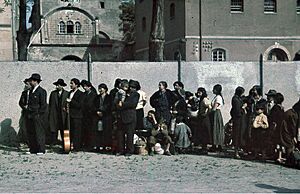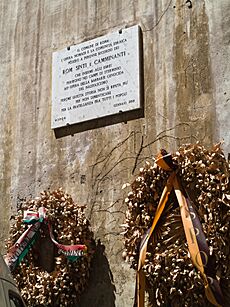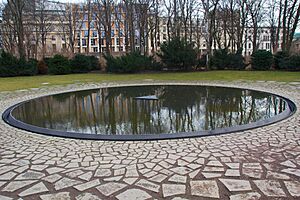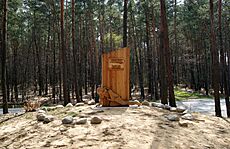Romani Holocaust facts for kids
Quick facts for kids Romani Holocaust |
|
|---|---|
| Part of World War II | |

European Roma and Sinti in Asperg, Nazi Germany, are rounded up for deportation by Nazi German authorities on 22 May 1940.
|
|
| Location | Nazi Germany and its occupied territories |
| Date | 1939–1945 |
| Target | European Roma and Sinti |
|
Attack type
|
Genocide, ethnic cleansing, mass murder |
| Deaths | At least 150,000. Other estimates give figures such as 500,000 800,000 or even as high as 1.5 million. |
| Perpetrators | Nazi Germany and its allies |
| Motive | Antiziganism, Germanisation, Pan-Germanism, Racism, Nazi racial policy |
The Romani Holocaust or the Romani genocide was the planned effort by Nazi Germany and its World War II allies and collaborators to commit ethnic cleansing and eventually genocide against European Roma and Sinti peoples during the Holocaust era.
Under Adolf Hitler, a supplementary decree to the Nuremberg Laws was issued on 26 November 1935, classifying the Romani people (or Roma) as "enemies of the race-based state", thereby placing them in the same category as the Jews. Thus, the fate of the Roma in Europe paralleled that of the Jews in the Holocaust.
Historians estimate that between 250,000 and 500,000 Romani and Sinti were killed by Nazi Germans and their collaborators—25% to over 50% of the estimate of slightly fewer than 1 million Roma in Europe at the time. Later research cited by Ian Hancock estimated the death toll to be at about 1.5 million out of an estimated 2 million European Roma.
In 1982, West Germany formally recognized that Nazi Germany had committed genocide against the Romani people. In 2011, Poland officially adopted August second as a day of commemoration of the Romani genocide.
Within the Nazi German state, first persecution, then extermination, was aimed primarily at sedentary "Gypsy mongrels". In December 1942, Heinrich Himmler ordered the deportation of all Roma from the Greater Germanic Reich, and most were sent to the specially established Gypsy concentration camp at Auschwitz-Birkenau. Other Roma were deported there from the Nazi-occupied Western European territories. Approximately 21,000 of the 23,000 European Roma and Sinti sent there did not survive. In areas outside the reach of systematic registration, e.g., in the German-occupied areas of Eastern and Southeastern Europe, the Roma who were most threatened were those who, in the German judgment, were "vagabonds", though some were actually refugees or displaced persons. Here, they were killed mainly in massacres perpetrated by the German military and police formations as well as by the Schutzstaffel (SS) task forces, and in armed resistance against the Nazi German occupation of Europe.
Recognition and remembrance
The German government paid war reparations to Jewish survivors of the Holocaust, but not to the Romani. There were "never any consultations at Nuremberg or any other international conference as to whether the Sinti and Roma were entitled like the Jews to reparations." The Interior Ministry of Wuerttemberg argued that "Gypsies [were] persecuted under the Nazis not for any racial reason but because of an asocial and criminal record".
Acts of commemoration

The first memorial which commemorates victims of the Romani Holocaust was erected on 8 May 1956, in the Polish village of Szczurowa commemorating the Szczurowa massacre. Since 1996, a Gypsy Caravan Memorial has been traveling among the main remembrance sites in Poland, from Tarnów via Auschwitz, Szczurowa and Borzęcin Dolny, gathering the Romani and well-wishers in the remembrance of the Porajmos. Several museums dedicate a part of their permanent exhibition to documenting that history, such as the Museum of Romani Culture in Czech Republic and the Ethnographic Museum in Tarnów in Poland. Some political organisations have tried to block the installation of Romani memorials near former concentration camps, as shown by the debate over Lety and Hodonin in the Czech Republic.
On 23 October 2007, President Traian Băsescu publicly apologized for his nation's role in the Porajmos, the first time a Romanian leader has done so. He called for the Porajmos to be taught in schools, stating that, "We must tell our children that six decades ago children like them were sent by the Romanian state to die of hunger and cold". Part of his apology was expressed in the Romani language. Băsescu awarded three Porajmos survivors with an Order for Faithful Services. Before recognizing Romania's role in the Porajmos, Traian Băsescu was widely quoted after an incident on 19 May 2007, in which he insulted a journalist by calling her a "stinky gypsy". The president subsequently apologized.
On 27 January 2011, Zoni Weisz became the first Roma guest of honour at Germany's official Holocaust Memorial Day ceremony. Dutch-born Weisz escaped death during a Nazi round-up when a policeman allowed him to escape. Nazi injustices against the Roma were recalled at the ceremony, including that directed at Sinto boxer Johann Trollmann.
In July 2011, the Polish Parliament passed a resolution for the official recognition of 2 August as a day of commemoration of the genocide.
On 5 May 2012, the world premiere of the Requiem for Auschwitz, by composer Roger Moreno Rathgeb, was performed at the Nieuwe Kerk in Amsterdam by The Roma and Sinti Philharmoniker directed by Riccardo M Sahiti. The Philharmoniker is a pan-European orchestra of Roma and Sinto musicians generally employed by other classical orchestras; it is focused on the contribution of Roma culture to classical music. Dutch-Swiss Sinto Moreno Rathgeb wrote his requiem for all victims of Auschwitz and Nazi terror. The occasion of the premiere was coupled to a conference, Roma between Past and Future. The requiem has since been performed in Tilburg, Prague, Budapest, Frankfurt, Kraków, and Berlin.
On 24 October 2012, the Memorial to the Sinti and Roma Victims of National Socialism was unveiled in Berlin. Since 2010, ternYpe – International Roma Youth Network has organized a commemoration week called "Dikh he na bister" (look and don't forget) about 2 August in Kraków and Auschwitz-Birkenau. In 2014 they organised the largest Youth Commemoration Ceremony in history, attracting more than 1000 young Roma and non-Roma from 25 countries. This initiative of ternYpe Network was held under the European Parliament's High Patronage granted by President Martin Schulz.
Images for kids
-
German troops round up Romani in Asperg, Germany, in May 1940
See also
- Roma Holocaust Memorial Day
- Gypsy family camp (Auschwitz)
- Romani studies
- Romani people







